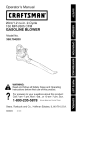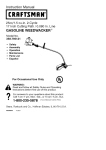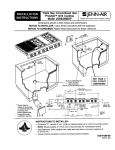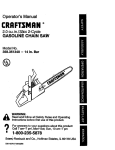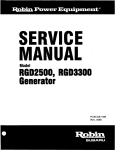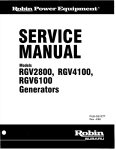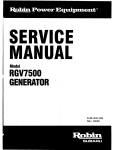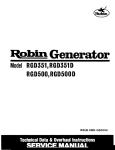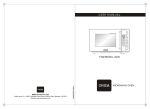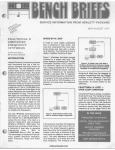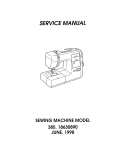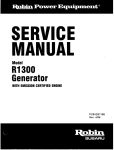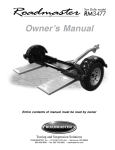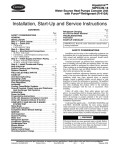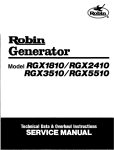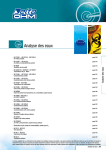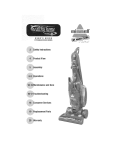Download RGD5000 GENERATOR SERVICE MANUAL
Transcript
MAN,UAL Model RGD5000 Generator PUB-GS1187 Rev. 8198 . CONTENTS nt/e section . Page ....................................................................................................... 1 SPECIFICATIONS . ........................................................................................... 2 PERFOMANCE CURVES 2-1 MODEL RGD5000 .................................................................................................. 2-2 DC OUTPUT ......................................................................................................... 1 2 2 2 . .................................................................................................................. 3 4.GENERAL DESCRIPTION .......................................................................................... 4 3 FEATURES 4-1 EXTERNAL VIEW ................................................................................................. 4-2 CONTROL PANEL ................................................................................................ 4-3 LOCATION of SERIAL NUMBER and SPECIFICATION NUMBER...................... . ........................................................................... 5 CONSTRUCTION AND FUNCTION 4 5 6 7 5-1 CONSTRUCTION ................................................................................................. 7 5-2 FUNCTION............................................................................................................ 7 5-3 GENERATOR OPERATION ................................................................................ 11 *- . ......................................................................................... 14 7. RANGE OF APPLICATIONS .................................................................................... 15 8. MEASURING PROCEDURES.................................................................................. 18 6 SAFETY PRECAUTIONS 8-1 MEASURING INSTRUMENTS ........................................................................... 8-2 AC OUTPUT MEASURING ................................................................................. 8-3 DC OUTPUT MEASURING ................................................................................. 8-4 MEASURING INSULATION RESISTANCE ........................................................ 9 CHECKING FUNCTIONAL MEMBERS 9-1 VOLTMETER ....................................................................................................... 9-2 AC RECEPTACLES ............................................................................................ 9-3 NO-FUSEBREAKER ........................................................................................... 9-4 STATOR .............................................................................................................. 9-5 ROTOR ASSEMBLY ........................................................................................... 9-6 CONDENSER ..................................................................................................... 9-7 DIODE RECTIFIER ............................................................................................. 10 DISASSEMBLY AND ASSEMBLY 10-1 PREPARATION and PRECAUTIONS ............................................................... 10-2 SPECIAL TOOLSfor DISASSEMBLY and ASSEMBLY .................................... .................................................................... . . ” .......................................................................... 18 21 21 22 24 24 24 24 25 26 27 27 29 29 29 Section Tile 10-3 DISASSEMBLY PROCEDURES ....................................................................... 10-4 ASSEMBLY PROCEDURES ............................................................................. paw 30 39 10-5 CHECKING. DISASSEMBLY and REASSEMBLY of the CONTROL BOX ....... 50 . ............................................................................................ . ................................................................................................. 11 TROUBLESHOOTING 52 11-1 NO AC OUTPUT................................................................................................ 52 S TOO THIGH OR TOO LOW................................................... 54 11-2 AC VOLTAGE I 11-3 AC VOLTAGE IS NORMALAT NO-LOAD. BUTTHE LOAD CANNOT BE APPLIED ..... 55 11-4 NO DC OUTPUT ............................................................................................... 56 12 WIRING DIAGRAM 57 Model RGD5000 Brushless, Self Exciting, 2-Pole, Single Phase JYPe 60 Hz Frequency a 5g ! AC Maximum Output 5000 W Rated Output 4500 W 120 v 51 a Current 1 I 12OV/24OV I 37.5 A 1.o Power Factor DC Output 12 V-8.3 A (100 W) I Regulator Voltage Type Condenser Air-Cooled 4-Cycle, Diesel Engine Model DY41 D tcDisplacement [I 412 cm3 (25.14 cu. in.) Rated Output 8.5 HP / 3600 rpm ~ W 37.5N18.814 II I ~~ ~ ~~ Diesel lightoil Fuel ~~~ ~ ~ Fuel TankCapacity 1 1 4.2 U.S. gal. (16.0 liters) 1 Rated Coutinuous Operation 1 2.0 hours Oil Capacity Starting System Dimensions (L x W x H) 2.3 U S . gal. (1.1 liters) i I Electric Starter Recoil Starter and 26.5 x 19.7 x 21.3 in (675 x 500 x 542 mm) Dry Weight 95 kg (209Ibs.) Electric starter motoris available as option. - 1- I 2. PERFOMANCE CURVES 2-1 MODEL RGD5000 t - -63 P * zi= 6 610 E K Y 1 s: -g 2 Output Max. ................. 5000 W Output Rated ............... 4500 W Frequency .................... 60 Hz Voltage ......................... 120 V 5k 62 4k 59 2k t -2 c c 130 3 lk 0 120 110 h - 3 10 20 30 CURRENTO 0 0 50 40 Output Max. .............. 5000 W Output Rated ............4500 W Frequency .................60 Hz Voltage ...................... 120 Vl24OV 2-2 DC OUTPUT DC Voltage .................. 12 V -= DC Ampere .................8.3 A DC output .................... I6 Lu 14 The voltage cuwe shown in the left indicates the characteristic of DC output when charging a battery. The voltage may be decreased by 20% when the resistance loadis applied. 12 gIO 0 100 W 2 - 4 6 8 CURRENT(A) 1 NOTE :It is possible to use both DC and AC outputs simultaneouslyup to the rated output in total. 0 - 2- * 3.FEATURES 3-1 BRUSHLESSALTERNATOR Newly developed brushlessalternator eliminates troublesome brush maintenance. 3-2 EASY STARTING Light pull recoil starter accompanied with automatic decompression system makes the new RGD series generators even easier instarting than gasoline engine generators. 3-3 QUIET OPERATION The new RGD series generator provides quiet operation by means of: The superb design of intake-exhaust system. Direct injection combustion system. 0 A large super silent muffler. An efficient low noise air cleaner. 3-4 ECONOMICALPERFORMANCE On top of well known diesel economy, the air-cooled Robin diesel engine features direct fuel injection and special design refinements for extra fuel efficiency. 3-5 OIL SENSOR The OIL SENSOR automatically shuts the engine off whenever the oil level f& down below a safe level preventing engine seizure. 3-6 COMPACT, LIGHT WEIGHT The combination of newly developed brushless alternator and air-cooled single cylinder Robin diesel engine enables the new RGD series generators to bevery compact in size and light in weight. 3-7 RELIABLE PERFORMANCE WITH MINIMAL MAINTENANCE A brushless alternator eliminates troublesome brush maintenance. A dripproof alternator design. A trouble free condenser voltage regulator. A fuseless circuit breaker. A dust-proof oil-bath air cleaner. The OIL SENSOR automatically shuts the engine off whenever the oil level falls down belowa safe level preventing engine seizure. 3-8 LONG-LIFE DURABILITY 0 0 Compact and smooth running air-cooled Robin dieselengine lasts much longer than the gasoline engine of the same size. Trouble-free brushless alternator with condenser type voltage regulator works all the year round without any maintenace work. - 3- 4.GENERAL DESCRIPTION 4-1 EXTERNAL VIEW Rocket cover Fuel gauge \ Air cleaner \ ACreceptack \ Tank cap / - 4- Muffler 4-2 CONTROL PANEL RGD5000 : 60HZ-l20V, 60Hz-l2OV/240VTYPE Voltmeter Full power switch AC Earth terminal - 5- DC output terminal 4-3 LOCATION of SERIAL NUMBER and SPECIFICATION NUMBER Serial number and specification number are stamped onLABEL the (MODEL NAME) stuck on the side wall of control box. NOTE :Always specify these numbers when inquiring about the generator or ordering spare parts in order toget correct parts and accurate service. Serial number - 6- e 5CONSTRUCTIONAND FUNCTION " !j-lCONSTRUCTlON Mount rubber Generator base \ Driving shaft Starterpu"ey Stator bolt Ball bearing Fig. 5-1 5-2 FUNCTION 5-2-1 STATOR Thestatorconsists of alaminatedsiliconsteel sheet core,a mainc o i l and a condenser coil which are woundin the core slots. I The condenser coil excites the rotor field coil which generates AC voltage in the main coil. Fig. 5-2 - 7- \ Adapter 5-2-2 CONDENSER One or two condensers are installedin the control box and are connected to the condenser coil of the stator. These condensers and condenser coil regulate the output voltage. 5-2-3 ROTOR The rotor consists of a laminated silicon s t e e l sheet is wound over the core. core anda field coil which DC current in the field coil magnetizes the steel sheet core.Two permanent magnets are provided for the primary exciting action. Fig. 5-4 A diode rectifier and surge absorber is mounted insideof the insulator. Fig. 5-5B Fig. 5-5A - 8- 5-24 DC FUSE (1) The 10 ampere DC fuse mounted on the control panel protectswhole DC circuit from getting damage by overload or short circuit. (2) The 15 ampereDC fuse in the control box protects the diode rectifier from getting damage by reverse connection to the battery. (Electric start model) L Fig. 5-6 5-2-5 NO-FUSE BREAKER The no-fuse breaker protects the generator from getting damage by overloading or short circuit in the of protection. appliance.Table 5-1 shows the capacityof no-fuse breaker by each spec. and their object MODEL SPECIFICATION NO-FUSE BREAKER OBJECT or PROTECTION 37.5 A Total output amperage Output from 30A receptacle Total output amperage Output from 3OA receptacle 60 HZ-120V 30 A RGD5000 /- 20Ax2 60 HZ-120V, 240V 30 A Table. 5-1 Fig. 5-7 - 9- 5-2-6 RECEPTACLEand AC PLUG (STD.SPEC.) These areused for takingAC output power from the generator. A total of six kindsof receptacles, each varying in rated voltage and current from another, are used. Each model has at least one receptacle to output. As many AC plugs as the receptacles, each matching the corresponddeliver the rated generator ing receptacle, are provided. Table 5-2 shows the rated current for each receptacle. Be careful not to use to prevent burning. the receptacles andAC plugs beyond the specified amperage limits w I' W NOTE 1 :If your generator has receptacles pecu5-2 does not liar to your country, Table apply. NOTE 2 :The generator for U.S.A. market is equipped with NEMA standard receptacles shown in table5-2. Use the proper plug for connectingappliance to the generafoE Caution :To connect the applianceto locking receptacle, insert the plug into the r e ceptacle and turn it clockwiseto lock Fig. 5-8 style El Ampere 125V 20A Receptacle AC plug NEMA NEMA 5-20R Circuit Interrupter) 5-20P Description GFCI (Ground Fault Receptacle, duplex @ 125V/ 250V 20A NEMA L14-20R NEMA L14-20P Locking Receptacle @ 125V 30A NEMA NEMA L5-30P Locking Receptacle E-30 Table. 5-2 - 10- PERMANENT MAGNET STATOR FOR INITIALEXCITATION COIL FIELD ,I APPLIANCE " " " I I , """" fig,5-9 5-3-1GENERATlON Of NO-LOAD VOLTAGE (1) When the generator starts running, the permanent magnet built-in to the rotor generates 3 to 6V of AC voltage inthe maincoil and condenser coil wound on the stator. (2) As one ortwo condensers are connected to the condenser coil, the small voltage at the condenser which I flows through the condenser coil. At this time, a smallis flux coil generatesa minute current@ produced with which the magnetic force at the rotor's magnetic is pole intensified.When this magnetic force is intensified, the respective voltages in the main coil and condensercoil riseup. As the current @$increases, the magnetic flux at the rotor's magnetic pole increases further. Thus the voltages at the main coil and condenser coil keep rising by repeating this process. (3)As AC current flows through the condenser coil, the density of magnetic flux in the rotor changes. T in the field coil change of magnetic flux inducesAC voltage in the field coil, and the diode rectifier circuit rectifies thisAC voltage intoDC. Thus aDC current @ flows through the field coil and magnetizes the rotor coreto generate an output voltage in the main coil. (4) When generator speed reaches3000 to 3300 rpm, the current in the condensercoil and field coil to stabilize the output voltage of each coils. If generator speed further increases rapidly. This acts will reach to the rated value. increases to the rated value, the generator output voltage 5-3-2 VOLTAGE FLUCTUATIONS UNDER LOAD When the output current @ flows through the main coil to the appliance, a magnetic is produced flux and @ in the I condenser coil. When current increases, the densityof magnetic serves to increase current As a result, the current flowing the in field coil increases and the generaflux across the rotor core rises. tor output voltage is prevented from decreasing. a - 11 - 5-34 FULL POWER SWITCH (Dual Voltage Type) The full power switch is provided for the dual voltage type to take out thefull rated power from one receptacle in eachvoltage. I Fig. 5-10 L \ 3MCz / Fig. 5-11 w LOWER VOLTAGE HIGHER VOLTAGE Switch 1 110 v lgv I RECEPTACLE RECEPTACLE Rated output No output can be taken. 11 o m 0 v or 120/240v Half of rated output Table. 5 4 - 12 - Rated output .- Two main coils are wound over stator core. Each main coil outputs half the rated power at the lower Thepower switch voltage (11OV or 120V). These main coils are wound to be in the same phase. full reconnects these main coils in parallel or in series. Fig. 5-10 shows a circuit diagram. When the full power switch is set for single lower voltage indication (11OV or 120V), the switch positionis as indicated by the lower solid line in the diagram. Fig.5-11 is a simplified representation of this circuit, showing two the main coils connected in parallel.ln this case, the higher voltage(220V or 240V) at Rec. 3 cannot be taken out. Rec. 2 for the lower voltage can output up to the rated power (up to 30A if the rated current is over 30A), and Rec.1 can output up to a total of15A. When the full power switch is set for double voltage indication (11OV/22OV or 120V/240V), the switch line Fig. 5-10. Fig. 5-12 is a simplified representation of this position is as indicated by the upper dotted in circuit, showing thetwo main coils connectedin series. In this case, power can be taken simultaneously both voltages. Rec. 3 for the higher voltage can output up to the rated power, from the receptacles for the uphalf the rated power each. but Rec. 1 and Rec. 2 for the lower voltage can output only to Table 5-4 is asummary of the above explanation. Select the proper output voltage by full power switch in accordance with the appliance to be used. - 13- 6. SAFETY PRECAUTIONS 1. Use extreme caution near fuel. A constant danger of explosion or fire exists. w Do not fill the fuel tank while the engineis running. Do not smoke or use opern flame near the fuel If spilt, wipe it and let dry before starting the engine. tank. Be careful not to spill fuel when refueling. 2. Do not place inflammable materials near the generator. Be careful notto put fuel, matches, gunpowder, oily cloth, straw, and any other inflammables near the generator. 3. Do not operate the generator in a room,cave or tunnel. Always operatein a well-ventilated area. Otherwise the engine may overheat and also, the poisonous carbon monoxide contained in the ex1 m (4 feet) away from structures haust gaseswill endanger human lives. Keep the generator at least or facilities during use. 4.0perate the generator on a level surface. If the generator is tilted or moved during use, there is a ofdanger fuel spillage and a chance that the generator maytip over. 5. Do not operate with wet hands or in the rain. If the generatoris wet by rain or snow, wipe it and thoroughly dryit Severe electric shock may occur. before starting. Don’ t pour water over the generator directly nor it with washwater. If the generatoris wet with water, the insulations will be adversely affected and may cause current leakage and electric shock. 6. Do connect not 4 the generator to the commercial power lines. This may causea short-circuit or damageto the generator. Use a transfer switch (Optional parts) for connecting with indoor wiring. NOTE :The parts numbers of the trawfer switches and of the plasticbox to store themare asshown in Table 6-1. Part No. Part Name Qlty Phase Allowable Current 365-45604-08 Transfer Switch 1 1 15 A 367-45605-08 Transfer Switch 1 1 30 A 340-45606-08 Transfer Switch 1 1 60 A 367-43008-08 Plastic Box 1 1 30 A 34843009-08 Plastic Box 1 1 60 A Table. 6 1 7. Be sure to checkand remedy the cause of circuitbreaker tripping before re-setting it on. appliance,the cause CAUTION :If the circuitbreaker tripped off as a result of using an electrical can be an overloador a short-circuit. In such a case, stop operation immediately and carefully check the electricalappliance and AC plugs for faulty wiring. - 14- Generally, the power rating of an electrical appliance indicates the amount of work that be done can byit. The electric power required for operating an electrical appliance is not always equal to the output wattage of the appliance.The electrical appliances generally have a label showing their rated voltage, frequency, and power consumption (input wattage). The power consumption of an electrical appliance is the power necessary for using it. When using a generator for operating an electrical appliance,the pow factor and starting wattage must be taken into consideration. In order to determinethe right size generator,it is necessary to add the total wattage of all appliances to be connected to the unit. of each appliance or equipment by its type. Refer to the followingsto calculate the power consumption (1) Incandescent lamp, heater, etc. with a power factor of 1.O Total power consumption must be equal to or less than the rated output of the generator. Example :A rated 3000W generator can turn thirty1OOW incandescent lamps on. (2) Fluorescent lamps, motor driven tools, light electrical appliances, etc. with a smaller power factor Select a generator with a rated output equivalent to1.2 to 2 times of the power consumption of the 1.2 to 3 load. Generally the starting wattage of motor driven toolslight and electrical appliances are times lager than their running wattage. Example : A rated 250 W electric drill requires 400 a W generator to start it. NOTE7 :If a power factor correction capacitor is not applied to the fluorescent lamp, the more power shall be required to drive the lamps. NOTE2 :Nominal wattage of the fluorscent lamp generally indicates the output wattagetheoflamp. the power consumption, effiTherefore, if the fluorescent lamp has no special indicationtoas on the following page. ciency should be taken into account as explained in (5) Item (3) Mercury lamps with a smaller power factor Loads for mercury lamps require 2 to 3 times the indicated wattage during start-up. Example :A 400 W mercury lamp requires 800 W to 1200 W power source to be turned on. A rated 3000 W generator can powertwo or three400 W mercury lamps. (4) Initially loadedmotor driven appliances such as water pumps,compressors,etc. These appliances require large starting wattage which is 3 to 5 times of running wattage. Example :A rated 900 W compressor requires a4500 W generator to driie it. NOTE7 :Motor-driven appliances require the aforementioned generator output only at the starting. Once their motors are started, the applianceswnsume about 7.2 to 2 times their rated power consumption so that the excesspower generated by the generator can be used forother electrical appliances. NOTE2 :Motor-driven appliances mentioned in Items(3) and (4) vary in their required motor starting power dependingon the kind of motor and start-up load.isIf difficult it to determine the Optimum generator capacw, select a generator with a larger capacity - 15- (5) Appliances without any indicationas to power consumption Some appliances have no indication as to power consumption; but instead the work load (output) is indicated. In such a case, power consumption is to be worked out according to the numerical formula mentioned below. (Output of electrical appliance) (Efficiency) = (Power consumpition) Efficiencies of some electrical appliances are as follows : ................................ 0.6 to 0.75 0.65 to 0.9 Three-phasemotor ................................ Fluorescent lamp................................... 0.7 to 0.8 Single-phasemotor Thesmallerthemotor,the lowertheefficiency. Example 1: A 40W fluorescent lamp means that its luminous outputis 40W. Its efficiency is 0.7 and accordingly, power consumptionwill be 40 f 0.7=57W.As explained in Item(2),multiply 57 W by 1.2 to 2 and you will get the figure of the necesthis power consumption value of sary capacityof a generator. In other words, a generatorwith a ratedoutput of 1OOOWcapacity can light nine to fourteen 40 W fluorescent lamps. Example 2 :Generally speaking, a400 W motor means thatits work load is400 W. Efficiency of this motor is 0.7 and power consumption will be 400+0.7=570 W. When this motor is used for 570 W a motor-driven tool, the capacity of the generator should be multiple of by 1.2 to 3 as explained in the Item(3). 570 (W) x 1.2 to 3 = 684 (W) to 1710 (W) MODEL RGD5000 60 Hz Frequency lncandesent lamp, heater, etc. Fluorescent lamp, Motordriven tool, general-porpose I I 4500 w I approx. 3000 W approx. Mercury lamp,etc. Pump, compressor, etc. 2700 W I Table. 7-1 - 16- U P NOTES :Wring between generator and electrical appliances I . Allowable current of cable Use a cable W h an allowable current that is higher than the rated input current of the load (electrica appliance). If the input currentis higher than the allowable currentof the cable used, the cable will become excessively heated and deteriorate the insulation, possibly burning it out. Table 7-2 shows cables and their allowable currents for your reference. 2.Cable length If a long cableis used, a voltage dropoccurs due to the increased resistance in the conductors decreasing the input voltage to the load (electrical product). As a result, the load can be damaged. Table 7-2 shows voltage drops per 100 meters of cable. No’ Sectional Allowable wire element Resistance area I mm3 current I A NoJ mm -II 7 30 10.18 12 50 I 0.18 17 37 I 0.26 0.517 23 5.5 35 1.486 70 I 0.32 0.332 Table. 7-2 Voltage drop indicatesas V= 1 x R xIxL 100 R means resistance ( 62 / 100 m) on the above table. I meanselectriccurrentthroughthewire L meansthelength of thewire (m). (A). The lengthof wire indicaters round length, it means twice the length from generator to electrical tools. - 17- 8. MEASURING PROCEDURES 8-1 MEASURING INSTRUMENTS 8-1-1 “Dr. ROBIN” GENERATOR TESTER The “Dr. Robin” generator tester is exclusively designed for fast, easy diagnosisand repair of Robin generators.The “Dr. Robin” has the following features: (1) Functions of voltmeter, frequency meter, meggertester, capacitance meter and circuit tester are combined in one unit. w (2)Fast and easy readout by digital indicator. (3) Built-in automatic battery checker indicates the time to change batteries. Fig. 8-1 (4) Tester and accessories are installed in a handy, sturdy case for easy carring. SPECIFICATIONS Number Dr. Robin MODEL 388-47565-08 Part Voltage Oto500VAC ~ 1 Measuring Range Condenser Capacity ~ 25 to 70 Hz Resistance I ~~ 0.1 to 1.999 Q I 10to100 p F 2 x 6F44P (006P)Dry C e l l Battery Source Power Test leads with needle probes . . . 1 set Test leads with jack plugs . . , 1 set Accessories 285 mm x 200 mm x 110 mm Dimensions (L x W x H) Weight 1.6 kg Table. 8-1 The “Dr. Robinngenerator tester can be ordered from Robin generator distributors by the following part number. Dr. Robin Part Number :38847565-08 If you do not have a “Dr. Robinngenerator tester,use the instruments described in the following section for checking generator parts. - 18- 8-1-2 INSTRUMENTS (1) VOLTMETER AC voltmeter is necessary. The approximate beto used AC voltage ranges of the voltmeters for various typesof generators are as follows: 0 to 150V :Type with an output voltage 11 of0 or 120V 0 to 300V:Type with an output voltage of 220, 230 or 240V 0 to 15OV, 0 to 330V : Dual voltage type FOR AC L Fig. 8-2 (2) AMMETER AC ammeter is necessary. An AC ammeter with a range that can be changed according to the current ratingof a given generator is most desirable. (About 10A, 20A, 1OOA) FQR AC Fig. 8-3 (3) FREQUENCYMETER Frequency range:About 45 to 65Hz NOTE :Be careful ofthe frequency meter's input voltage range. Fig. 8-4 " - 19- (4) CIRCUITTESTER Used for measuring resistance, etc. (5) MEGGER TESTER Used for measuring generator insulationresistance. Select one with testing voltage range of 500V. I Fig. 8-6 (6) TACHOMETER Use the contactless type tacho meter. I Fig. 8-7 - 20- 8-2 AC OUTPUT MEASURING I d TO AC RECEPTACLE I 1 1 c I n U Fig. 8-8 Use a circuit like the shown in Fig.8-8 for measuring AC output. A hot plateor lamp with a power factor of 1.0 may be usedas a load. Adjust the load and rpm. and check that the voltage range is as specifiedin Table 8-2 at the rated amperage and rated rpm. Rated voltage 120 v 240 v Voltage range 117 - 1 3 0 V 235 - 260 V Table. 8-2 8-3 DC OUTPUT MEASURING " To DCTerminal Fig. 8-9 Measurement of DC output is executedwith the switch turnedON while the currentis regulated at 8.3A by adjusting the load to the generator. If the voltageis within the range from 6V to 14V, the voltageoutput is normal. NOTE :I f a battery is connected as a load to the generator, theDC output voltage will increase by approximately 7 to 2 V: Therefore, careful& observe the electrolyte level and do not overcharge the battery - 21 - 8 4 MEASURING INSULATION RESISTANCE Use a "Dr. Robinngenerator tester in megger tester mode or use a megger tester to check the insulation resistance. Connect a megger tester to one of receptacleoutput terminals and the ground terminal, then measure the insulation resistance. An insulation resistanceof 1 megohm or more is norat the time mal. (The original insulation resistance of shipment from the factory is 10 megohm or more.) If it is less than 1 megohm, disassemble the generator and measure the insulation resistance of the stator, rotor and control panel individually. i I I U ' * STATOR i (1) Measure the insulation resistance between BLUE lead and the core. (2)Measure the insulation resistance between WHITE lead and the core. (3) Measure the insulation resistance between YELLOW lead and the core. (4) Measure the insulation resistance between BROWN lead and the core. Fig. 8-11 ROTOR Measure the insulation across one of the soldered terminals of the rotor andthecore. ~ Fig. 8-12 - 22- CONTROL PANEL Measure the insulation resistances between the live parts and the grounded parts. =4 I fig. 8-13 Any part where the insulation resistanceis less than 1MQ has faulty insulation,and may cause electric leakage and electric shock. Replace the faulty part. - 23- 9.CHECKING FUNCTIONAL MEMBERS 9-1 VOLTMETER Check the the voltmeter if it is turned on by applying specific voltage. Voltmeter cannot be checked with circuit tester because its resistance is too large. 9-2 AC RECEPTACLES Using a "Dr. Robinnora circuit tester, check continuity between thetwo terminals at the rear of the AC receptacles while the receptacleis mounted on the control panel. Fig. 9-1 When continuityis found between the output terminals of the receptacle with a wire connected across these terminals, the AC receptacle is normal. When the wire is removed and no continuity is found between these terminals, the receptacles are also normal. AC receptacle \ I I W Wire Fig. 9-26 Fig. 9-2A 9-3NO-FUSEBREAKER I Check continuity between each of two terminals at the rear of the no-fuse breaker while it is mounted on the control panel. Normally, there is continuity between each of the two when the nofuse breaker is on while there is no continuity when the no-fuse breakeris off. Circuit breake Fig. 9-3 - 24- 9-4 STATOR Disengage connectors on the wires from stator and check the resistance between wires with a "Dr. Robin" or a circuit tester referingto the following table. i I u Fig. 9-4 Specification MODEL RGD5000 AC Winding Condenser Winding Hz Voltage White / Red Black / Blue Yellow / Yellow 6o 120v 120 V / 240 V 0.26 0.26 0.57 Tale. 9-1 NOTE :If the circuit tester is not sufficiently accurate, it may not show the values given and may give erroneous readings. Erroneous readings will also occurwhen there is a wide variation ofresistance among coil windings or when measurement is performed at ambienf.temperafures different from 20 OC (68 OF). - 25- 9-5 ROTOR ASSEMBLY (1) Using a "Dr. Robin"Or a Circuit tester, measure the resistance of the field coil at the terminals. ( Q ) MODEL RGD5000 RESISTANCE 1.6 Q Tble. 9-2 NOTE 7 : Because a diodeis soldered to the coil ends at the terminals, resistance may be measured only when tester probes touche the terminals in one combination of polarity merefore, if no resisfance reading appears, try cbecking in reverse polarity. NOTE 2 : If the circuit tester is not sufficiently accurate, it may not show the values given and may give erroneous readings. Erroneous reading will also occur when there is a wide variation of resistance among coil windings or when measurementis petformed at embient temperatures dfierent from 20 "C(68 OF). Fig. 9-5 (2)Check if the surge absorberis burnt. - Check the resistanceof surge adsorber. Normal resistance is $2 . (3) Measure the resistanceof the diode. Fig. 9-6 Polarity of circuit tester [Continuity exists.] I Fig. 9-7 - 26- 9dCONDENSER I Use a "Dr. Robin"in capacitance meter mode to check the capacity of condensers. NOTE :Be sure to discharge condensersby short- ing condenser leads each other before checking their capacitance,or the accurate reading cannot be obtained. NORMAL CAPACITY OF CONDENSER I ' Fig. 9-8 Table. 9-3 If such an instrumentis unavailable, the condenser can be checked by replacing with a new one. If the new condenser, the causeof trouble is defect in original condenser. generator performs good with 9-7 DIODE RECTIFIER Diode rectifier Circuit t e s t e r Fig. 9-9 Fig. 9-70 Circuit inside of the diode rectifiers is as shown in Fig. 9-9. Check continuity between each terminal by shown in Fig. 410.The rectifieris normal when condtinuityis as follows: using a circuit tester as - 27- Checkina tablefor analoaue circuit tester. of the circuit tester Apply black (minus) needle Analogue circuit tester Brown Brown Apply red (plus) needle of the circuittester - No continuity Orange Brown Orange Browmite - No continuity Continuity Continuity I I No continuity - Continuity Continuity I I No continuity No continuity e - Table. 94-1 Checkina tablefor diaital circuit tester. Apply red (plus) needle of the circuit tester Digital circuit tester Brown Brown - Brown No continuity ~~ Apply black (minus) needle of the circuit tester Orange BrownMlhite I Brown No continuity No continuity Continurty - No continuity Continuity Continuity I I No continuity - No continuity Continuity Continuity I I No continuity - Table. 9-4-2 NOTE I :Because of the differenceof measuring method between the analogue circuit tester and the of tester needles should be reversed. digital circuit tester, polarity NOTE 2 :"Continuity" means forward direction characteristicsof the diode, and different from short circuit condition (in which a pointer of the tester goesout of its normal scale),shows resjstance results of the checking indicates failure even in one section,replace with to some extent. When a new one. NOTE 3 :Simpson brand analogue testers have the characteristics as same as the digital circuit tester. - 28- 10. DISASSEMBLY AND ASSEMBLY 10-1PREPARATION and PRECAUTIONS 1) Be sureto memorize the location of individual parts when disassembling the generator so that the generator can be reassembled correctly. Tag the disassembled part with the necessary information to facilitate easier and smoother reassembly. 2) For more convenience,dividethe parts into several groups and store them in boxes. 3)To prevent bolts and nuts from being misplaced or installed incorrectly, replace them temporarily to their original position. 4) Handle disassembled parts with care; clean them before reassembly using a neutral cleaning fluid. 5) Use all disassembly/assembly tools properly, and use the proper tool for each specific job. 10-2 SPECIAL TOOLS for DISASSEMBLY and ASSEMBLY ROTOR PULLER REAR COVER PULLER - 29- JIG 10-3 DISASSEMBLY PROCEDURES 7 Step Part to remove 1 Remarks Description Fuel Tank (1) Discharge fuelfrom the tank. 1. Turn the fuel cock to close (S). 2. Disconnect the rubber pipe from the injection pump. (SeeFig. 10-1.) 3. Turn the fuel cock to OPEN (0)to discharge the fuel. (2) Disconnect the fuel pipe and return pipe from the tank bottom. (See Fig. 10-2.) 1. Remove the hose clamp and pull the fuel pipe off from the tank. 2. Remove the banjo bolt that fastens the return pipe. Wipe off spilt fuel. Pliers Do not lose the gasket 12 spanner 12 mm spanner or i box spanner : I (4) Remove the fuel fiter. 1. Remove the hose clamp,and pull out the air return pipe. (See Fig. 10-4.) Pliers 12 mm spanner or box spanner 2. Remove the fuel filter bolts and the fuel fiter. Fig. 10-1 F& 10-2 Fig. 10-3 Fig. 10-4 - 30- 17 mm spanner Do not lose the gasket. (3) Remove the fuel tank. After removing the nutand washer, remove the fuel tank. (See Fig. 10-3.) 89 Flange Nut . . . . . . 4 pcs. 89Washer. . . . . . . . . 4 pcs. -I Necessary tool ~~ , - I IPart to remove Battery (Only electric starter type) i 10 mm spanner or (2) Remove battery from battery base. Remove the two nuts that fasten the battery, and take off the battery holder, battery bolts, and battery. 6 9 n u t ........... 2pcs. (3) Remove battery base from the pipe frame. 6 9 b o l t . . . . . . . . . . . 2pcs. WNUT . . . . . . . 2pcs. @SPRING WASHER . . . . . . . . . .2pcs. B A l T E R Y SPACER ......... .2pa. Be careful not to short. (1) Remove battery cable from battery. Remove the negative side cablefirst,and then the positive side. box spanner i 10 mm spanner or box spanner I BAlTERYCABLE BATTERY ANGLE BATTERY BATTERY BOLT 4 1 dl i- v Fig. 10-5 PIPE FRAME I ~~ Part to remove Description Control Box Remarks (1) Take offthe bushing from thebottom I of the control box. OUT Fig. 10-6 1 (2) Take out the grommet from the bottom face of the control box. I \ c/ I Fig. 10-7 t I (3) Pull out t h e wiresforthe oil Sensor and electric starter, and remove them from i connectors. the Fig. 10-8 - 32- Press the upperend and pull out the bushing. Pan to remove Control Box Description t(4) Remarks Remove the control box from the frame. 64Washer.. ....... 3pcs. 6 4 b o l t . . ......... 3pcs. Nexesarytwl 10 mm spanner or box spanner Fig. 10-9 Pipe Frame (1) Remove side plate A. 69 bolt . . . . . . . . . . . 2 pcs. Remove the mount rubbers from side plate. (2) Remove the nutsand bolts that fasten the generatar and frame together. 1. Remove the two bolts which fur the alternator to the generator base. 2. Remove the four bolts and flange nuts which fuc the engine to the engine base. 8@bolt ........... 4 pcs. 84 flange nut . . . . . . . 4 p a . Nuts are welded to the generator base. 12 mm spanner or box spanner 80 FLANGE NUT.. 4 pa. 2 pa. RUBBER V.I. . . . 4 DQ. ENGINE BASE SIDE PLATE 80 BOLT A . . . . . - 2pa. . . . . . - 4 pes. Fig. 70-70 - 33- I Part to remove 1 PipeFrame Remarks Description t (3) Liftthe generator with a chain block 1 i! and dismount from the frame. (See Fig. 10-11.) Necesrarytod Be caref'd to keep the beltin place. r L Fig. 10-17 (4) Remove engine base, generator base, and mount rubbersfrom frame. NUT -100 I . . . . . . 4 pa. & FLANGE N U T . . 1 Pce. BASE GENERATOR BASE eRUBBERV.I. . . . 2 pa. % Fig. 10-12 - 34- RUBBER V.I. . . . 1 Pce. Remarks Description Part to remove Necessary tool 10 m m spanner or Recoil Starter (1) Remove recoil starter from rear cover. 69 bolt . . . . . . . . . . 4 pes. . box spanner 1 Fig. 10-13 - I I 1 Rear Cover 6 ! (1) Take off thethrough bolt and remove Be careful not to lose the starting pulley and spacer from rotor the key at removing shaft. Applya box wrench on the head starting pulley. of through boltand hit the wrench handle with a hammer counterclockwise toloosen f Fig. 10-15 Fig. 10-14 - 35- Box spanner or socket wrench Hammer 7 Step Part to remove Description Remarks (2) Take off the rear cover. 1. Remove the fourbolts which fasten the rear coverto the adapter of the engine. 6 4 b o l t . . . . . . . . . . . 4pcs. 2. Use a specialtool “REAR COVER PCLLER” to remove the rear cover. a) insert the two bolts of the special tool into thethread hole of the rear cover. b) Apply the center bolt of the special too1to the center hole of the rotor shaft. c) Tighten the center bolt to pull out the rear cover. BOLT Necessary tool 10 mm spanner or box spanner special tool Insert the two bolts 17 mm spanner sufficently and evenly or the thread hole may be damaged at removing. Driver . . . . . . 4pcs. ’ 60 BOLT BOLT . . . . . 2 pa. Fig. 10-I7 Fig. 10-16 PULLER”is unavailable, removethe rear cover by the following instructions. I . Insert the through bolt into the rotor shaft and tighten lightly. Hit on the bossand legs of rear cover with a plastic hammer. I In c a ~ ethat ‘REAR COVER II Do not give a strong hit on therear cover boss or legs. 1 Fig. 10-18 Box spanner or socket wrench Plastic hammer I Description 7 Neasssrytoal Remarks (1) Remove support ring. 1. Remove the fourbolts which fasten the statorto therear cover. 2. Insert a small hook into the hole inside of thesupport ring and pull it Stator I 10 mm socket out. @BOLT . . . . . . 4pa. &SPRING WASHER . . . . . . . . . ..%pes. 60 WASHER Fig. 10-20 I I (2) Take apart the stator from the rear cover. ’ I NOTE: Use utmost care not to give damage to the stator insulation and stator I leads I SUPPORT ‘@SPRING WASHER . . . . . . . . . . 4 pes. 60 BOLT Fig. 10-27 - 37- . . . . . . 4 pcs. . . . . 4 pa. part to remove ROTOR I I Description Remarks 17 mm spanner (1) Insert the rotor-puller shaft into the rotor, and tighten the rotor-puller bolt until the rotor comes loose. If the special tool is unavailable, take the following instructions to remove the rotor. Lightly strike the rotor corewith plastic hammer, and pull out therotor from the tapered shaft of theengine. Ifthe rotor cannot be taken off, strike it at different angles. (See Fig. 10-23.) ~~ Never strike on the coil. I I Adaptorand Driving Shaft mtic hamma ~ Fig. 10-23 Fig. 10-22 9 Necetrarytool (1) Remove the four adaptor mounting 12 mm spanner bolts, andthe adaptor. 8 9 b o l t . . . . . . . . . . . 4pcs. 14 mm spanner (2) Remove the four driving shaft mounting bolts, and the driving shaft. 109 bolt . . . . . . . . . . . 4 pa. 100 BOLT. . . . . . 4 pa. 1 0 0 SPRING WASHER . . . . . . . . . -4pCs. Fig. 70-24 ~ - 38- 1 0 4 ASSEMBLY PROCEDURES 10-4-1 FRONT PROTECTOR amd FRONT COVER (1) Aligh the driving shaft with the faucetofjoint the flywheel and install it. lO@x30mrnbolt... 4pcs. 10 # spring washer. . . 4 pcs. - 9 68.6 N-m - 550 700 kg-cm 39.8 50.6 ft-lb - (2) Install the adapter in the blower housing, making sure that flat its side is down and its fuel filter mounting boss on the air cleaner side. 8 # x25mmbolt ... 4pcs. 8 # spring washer. . . 4 pcs. filter nting boss 200 - 230 kg- 14.4 - 16.6 ft-lb L Fig. 10-25 10-4-2 ROTOR r (1) Clean the tapered portion of driving shaft and the matching tapered hole of rotor shaft of oil and dirt usinga waste cloth. (2) Attach the rotor to the engine shaft. Tighten the through bolt tentatively. (See Fig. 10-26.) Apply a wrench onthe head of through bolt and hitit clockwise with a hammer to tighten. - 39- 10-4-3 STATOR and REAR COVER (1) Set the stator on the jig so that grooves on the of the jig. stator side match with the grooves At the same time, be sure to set the stator on the jigso that the lead wires direct to the window of rear cover. Attach the support ring around the stator. are placed at the Check that the hooking holes flat sides of the stator. (See Fig. 10-27.) Direction of stator leads Grooves of stator I Grooves of jig N 1’ \U- Jig Fig. 10-27 (2)Insert four guide bolts in the rear cover and let them match with the grooves in the stator and set the rear cover over the stator. ” Board \ (3)Take the stator leads out from the window of the rear cover. (4) Tap lightly and evenly the upper surface of the board on the rear cover with plastic hammer to press fit the rear cover over the stator. (See Fig. 10-28.) Fig. 10-28 (5) Fix the statorto the rear cover with four bolts, 10-29.) washers and spring washers.(See Fig. 6 @ bolt. . - 4 pcs. 6 @ washer . . - 4 pcs. 6 @ spring washer. . . 4 pcs. I lighteningtorque I 4.9 5.9 N-m ~ - . . . . . . . .4 p a . 69 Spring washer. . . 4 p cs. 69 Bolt. 1 50 - 60 kgcm 3.6 4.3 fi-lb - Fig. 10-29 - 40- The dimensionsof the stator bolts are shown in Table 10-1. Tale. 10- 1 10-4-4 REAR COVER (1) Attach the bush over the lead wires drawn from outthe rear cover. of the rear cover. (SeeFig. 10-30.) Press the bush and into the window Fig. 1 0 3 0 (2)Put the rear cover with stator over the rotor. . Tap on the rear cover evenly with a plastic hammer to press the rotor bearing into the rear cover. (SeeFig. 10-31.) Fig. 1031 - 41 - (3)Fix the rear cover to the adapter with four bolts, spring washer, and washer. 6 @ x 2 5 m m b o l t ...4pcs. 6 @ washer. . . 4 pcs. 6 @ spring washer. . . 4 pcs. I Tightening torque - ~ I 4.5 5.9 N-m - 50 60 k- - 3.6 4.3 ft-lb 10-4-5 RECOIL STARTER (1) Remove the throughbolt which has been ten- tatively attached to therotor. (2) Insert the key into the keyway of the rotor shaft.(See Fig. 10-33.) Then, insert the spacer. Tapping the starterpulley with a plastic hammer, attach the starter pulley to the rotor shaft. Fig. 70-33 (3)Apply a washer anda spring washer to the through bolt and insert it into the rotor shaft. Through bolt . - . 1 pce. 10 @ washer . . . 1 pce. 10 @ spring washer. . . 1 pce. "The dimension of the through bolt is shown in Table 10-2. L t1 m I Model l Z I S l d l I I Table. 10-2 - 42- (4) Tighten the through bolt with a box wrench or a spanner. If an impact wrenchis available, use it. 240 - 300 kgcm 17.4 - 21.7 ft-lb (5)Attach the RECOIL STARTER to REAR COVER. 6 @ x 8 mm flange bolt. . . 4 pcs I Tightening torque - I 3.9 5.9 N-m 40 60 kg-cm 2.9 - 4.3 ft-lb - Fig. 70-35 (1) Attach two engine mount rubbersand one alternator mount rubberto the frame. (See Fig. 10-36.) 10 mm nut.. .2pcs. V.I. :1 pce. (2) Attach the engine baseto the bottomof the engine. (See Fig.10-37.) 8 @ x 50 mm flange bolt. . . 4 pcs. 8 @ nut . . . 4 pcs. NOTE :Insert the bolts fromh e bottom side of the engine base. 120 - 140 kgcm 8.7 - 10.1 ft-lb - Engine mountrubbers Engine mount holes Fig. 10-37 (3) Mount the generator base on the alternator mount rubber and fix with the nut. 8 @ nut. . . 1 pce. NOTE :Set the generator base so that the columnof the frame is placed in the center of the pipe on the bottom of the generator base. - 11.8 13.7 N-m 120 - 140 kg-m 8.7 10.1 ft-lb - I I Make this gap even. Fig. 10-38 (4) Install the engine and alternator assembly into the frame. a) Lift the engine and alternator assembly with a chain block, and downit into the frame, making sure that the bolts of the mount rubbers are correctly inserted into the engine base. b) Fix the engine and a alternator assembly to the mount rubbers.lighten the two nuts at engine base and two bolts at generator base. 10 @ nut.. - 2pcs. Tightening torque I - 235 29.4 N-m 240 - 300 kgcm 17.4 - 21.7 ft-lb L Fig. 70-39 - 44- 8 @ ~ 2 5 m m b o l... t 2pcs. I lightening torque - 11.8 13.7 N-m 120 - 140 kgcm 8.7 - 10.1 ft-lb NOTE :When tightening the nuts and bolts, slightly lift theengine and alternator assembly so that the weight is not applied to the mount rubbers (5) Attach the stoppers to the frame. NOTE 1 :Set the stoppers so that the engine base is placed in the center of the upper and the lower rubbers.(See Fig. 10-40.) Make this gap even. NOTE2 :If the engine mount rubbers are replaced so that with new ones, set the stoppers the upper rubber touches the engine base. The new mount rubber shall be distorted by approx. 3mm in one month. I Engine base II 1 Fig. 70-40 8 @ x 12 mm bolt I . . . . 4 pcs. lightening toque ~~ ~~ 11.8 I ~~ - 13.7 N-m - 120 140 kgcm 8.7 10.1 ft-lb - 45- (6) Attach side plateA to frame. 6 @ x 10 mm bolt.. .2pcs. Attach fuel tank mount rubbers to side plates. The nuts for mount rubbers are welded to side plates. I lightening toque I - 3.9 5.9 N-m - 1 40 60 kgcm 2.9 - 4.3 ft-lb 69 Bolt :2 I pcs. Fig. 10-41 10-4-7 CONTROL BOX Mount the control box assembly to the frame. Refer to Section 10-5 for disassembly, checking and reassembly proceduresof the control box. (1) Mount the control box to the frame. (See Fig. 10-42.) 6 @ x 10 mm flange bolt. . - 3pcs. 6 @ washer. . .3pcs. - 1 40 60 kg- 2.9 - 4.3 ft-lb I Fig. 10-42 - 46- _- (2) Connect the wires drawn out from the to stator the wires from the control box. Connect the oil sensor wiresat the same time. NOTE :Connect the wiresof the same color. (3) Press the upper end of the bushing into the bottom window of the controlbox. (See Fig. 10-43.) Attach the grommet for the oil sensor wires to the rear panelof the control box. t I Fig. 10-43 (4) Fasten the one earth cable with 8 C#I terminal drawn out from the control box to the rear cover leg. _- 8C#Ix25mmbolt... l p c e . Fasten the other earth cable with 6i"terminal to the unpainted bolt hole on the frame. (See Fig.1044.) - 11.8 13.7 N-m - 120 140 k g m 8.7 10.1 ft-lb - 1 Control box 6# Terminal 8# Terminal m Fig. 10-44 - 47- 10-4-8 BAlTERY (1) Attach ttach the battery base to the frame. - 6cpxlOmmbolt ...2pcs. 3.9 5.9 N-m - 40 60 kg-cm 2.9 4.3 ft-lb (2)Mount the battery on the battery base, and fix it with two battery bolts and a battery angle. (See Fig.10-45.) I - Tightening torque - I 3.9 5.9 N-m - 6 Q nut...2pcs. 40 60 kgcm 2.9 4.3 ft-lb 6 @ spring washer. . .2pcs. - (3) Attach battery cords to the battery. (-) cord. Attach the positive(+) cord first and then the negative Fasten the other end of the negative (-) cord tothe engine base using the engine mount nut. Battery cable frame Fig. 10-45 - 48- 10-4-9 FUEL TANK (1) Connect fuel pipe29 complete and rubber pipe(6 mm inside diameter,12 mm outside diameter, 170 mm long)to the fuel tank. a) Connect the rubber pipe and fasten it with the hose clamp(10.5 rnm inside diameter). 29 complete to both ends of the banjo and tightenit with banjo bolt using two pieces b) Connect fuel pipe of GASKET (ALUMINUM). Fuel tank 80 - 100 kg-cm 5.8 7.2 ft-lb - DIA. *1 Hose clamp inside DIA. 7.8 2 inside Hose clamp 10.5 Gasket (Aluminum) Fuel pipe 29 complete To Nozzle Rubber pipe (69 x 129 x 170 mm) Clamp To Injection pump . \ I 2 \ Rubber pipe (6# x 12# x 250 mm) Fig. 10-46 - 49- -\ \ Fuel filter assy (2) Mount the fuel tank on the mount rubbers attached to the side plates. 8 @ nut. . . 4 pcs. Tightening torque 8 rp spring washer. . . 4 pcs. - 11.8 13.7 N-m - 120 140 kg-cm 8.7 10.1 ft-lb (3) Connect the fuel pipe. a) Install the fuel filter assembly on the boss on the side of the adaptor (generator). 8 @ x 65 mm bolt. . . 1 pce. b) Connect the other end of the pipe installed in Step (1 ) to the fuel filter. Slide the hose clamp over the pipe, connect the topipe the fuel filter, and clamp the pipe at the cor rect point.Then, secure the pipe with the purse lock. NOTE :Connect the shorter pipe of fuel pipe 29 complete to thefud filter. Thehose clamp for the rubber pipe has an inside diameter of la5 mm, and thatfor fue/pipe 29 compiete is7.8 mm in inside diameter. c) Connect the longer pipe of fuel pipe 29 complete to the engine nozzle. The nozzle must be pulled up from the cylinder head before connecting the pipe to it. After pulling the nozzle up, slide the hose clamp (7.8 mm in inside diameter) over the pipe, connect the pipe to thenozzle, and fasten the pipewith the hose clamp at the correct point. Then, install the nozzle 9 on the head. Mount the bracket on the blower housing, and secure the pipe with the clamp. d) Connect the fuel filter and injection pump with pipe. Fit the banjo to the rubber pipe (6 mm in inside diameter, 12 mm in outside diameter,250 mm long) and clampit. Connect the other end of the pipe to the fuel filter and clamp it. Connect the banjo to the injection pump. A gasket must be placed on each side of the banjo. Use hose clamps 10.5 mm in inside diameter. Finally, clamp the pipe to the crankcase. 10-5 CHECKING, DISASSEMBLYand REASSEMBLY of the CONTROL BOX 10-5-1 CHECKING OF THE CONTROL BOX Dismount the control box from frame. Remove the control panel and check each components and wiri in the controlbox. Refer to Section9 for the detail of checking the components - 50- 10-5-2 DISASSEMBLY (1) Remove the control panel fromthe control box. Regulator 4 @ screw . . .8pcs. (2) Disconnect the connectors on thewires to detach the control panel and box. (3) Remove the regulator, oil sensor unit, condensers and diode rectifier from the control box. When removingthe regulator, push the hook on the coupler andpull out to disengage the couplers. (See Fig. 10-47.) (4) After disconnecting individual wires, remove 1 the control panel components. Fig. 10-47 NOTE :DC fuse, full power switch, pilot lamp and warning lamp have their wires soldered. Unsolder them to remove thoseparts ifnecessity 10-5-3 REASSEMBLY (1) Install the receptacles, no-fuse breaker, fuse, terminals, switches, etc.the oncontrol panel and wire them. NOTE :Circuit diagrams are shown in Section 12. Colored wires are usedforeasy identification, and are of the correct capacity and size. Use heat-resistant type wires (permissible temperature range 75°C or over) in the specified gauge shown in the circuit diagrams. (2) Install regulator, oil sensor unit, condensers, and diode rectifier into the box. control (3) Connect the wires of control panel components and control box. Fasten the earth wires tothe rearof the control box using a 6 @ nut to the bolt which fixes the condenser bracket to the inside of the control box. (See Fig. 10-48.) (4) Attach the control panel to the control box. 4 @ screw. . .8pcs. To Earth terminal Condenser bracket E &= I I Fig. 10-48 - 51 - 11.TROUBLESHOOTING I 11-1 NO AC OUTPUT l l -1-1 CHECKING STATOR Remove control panel and disconnect black, blue, red, and white wires at the connectors. Measure the resistance between terminals on stator leads. (See Fig.11-1.) Refer to Table11-1 for normal resistance.If stator is faulty, replace with a new one. Fig. 11-1 11-1-2 CHECKING CONDENSER If an instrument (QC-meter or C-meter) for measuring capacityof condenser is available, check 11-2.) the capacity of condenser. (See Fig. NORMAL CAPACITYOF CONDENSER - Table. 11 1 Fig. 11-2 If such an instrumentis unavailable, the condensercan be checkedby replacing witha new one. Ifthe generator performs good with new condenser, the cause ofistrouble defect in original condenser. - 52- 11-1-3 CHECKING OF ROTOR (1) CHECKING FIELD COIL Remove rem cover and startor. Unsolder the coil from the terminal on the rotor. (See Fig. 11-3.) Fig. 11-3 Measure the resistance of field coil with a circuit tester. (See Fig. 11-4.) [ Remedy ] I I I I MODEL RESISTANCE I I RGD5000 1.6 Q Table. 11-2 If the resistance is not normal, replace rotor with a new one. Fig. - 114 (2) CHECKING OF DIODES AND RESISTOR ON THE ROTOR Unsolder and takeout the diodes and a resistor from rotor. Measure the resistance of diodes. Polarity of I I [Continuity existsJ Fig. 11-5 Each rotor has three diodes. Check the resistanceof each diode. - 53- I Measure the resistanceof surge absorber connected to the diode holder. Normal resistanceis 0SZ . * Measure the resistanceof surge absorber connected to the diode holder. [ Remedy J 1. If the magnetic forceof rotor magnetsis weak, or if the surge absorberis not good, replacethe rotor with a new one. 2.If the diode is not good, replaceit with a new one. CAUTION :In case the diode troubles are frequent, check the surge absorber because it might be broken evenif its resistance is normal (aSZ).In such a case, replace the rotor with a new one. [ Reassembling ] Surge absorber 1. As shown in Fig. 11-6,place the whitemark on \ I the magnet to left and solder the diodes so that cathode mark is to be placed at the bottom. 2.Solder the coilends to the terminal. Fig. 11-6 11-2 AC VOLTAGEIS TOO HIGH OR TOO LOW. 11-2-1 CHECKING STATOR Check stator referringto Step 11 -1-1. 11-2-2 CHECKING CONDENSER Check condenser referring to Step 11 -1-2. 11-24 CHECKING ROTOR Check rotor referringto Step 11-1-3. - 54- 11-3 AC VOLTAGEIS NORMAL AT NO-LOAD, BUT THE LOAD CANNOT BE APPLIED. 7 11-3-1 CHECK THE ENGINE SPEED. If theengine speed is low, adjustit to the ratedr.p.m. 'Refer to Step11-2-1 for engine speed adjustment. 11-3-2 CHECK THE TOTAL WATTAGE OF APPLIANCES CONNECTEDTO THE GENERATOR. Refer to Section 7 "RANGE OF APPLICATIONS for the wattage of the appliances. If the generator is over-loaded, reduce the load to the rated output of the generator. 11-3-3 CHECK THE APPLIANCE FOR TROUBLE. If the appliance is faulty, repair it. 11-3-4 CHECK IF THE ENGINEIS OVERHEATED. If the cooling air inlet and/or cooling air outletis or other debris, reclogged with dirt, grass, chaff move it. Fig. 11-7 11-3-5 CHECK THE INSULATIONOF THE GENERATOR. Stop the engine. Measure the insulation resistance between the live terminalof the receptacle and the ground terminal. If the insulation resistance is less than1MQ, disassemble the generator and check the insulation resistance of the stator, rotor and the live parts in the control box. (Referto Section 8-3.) Any part where the insulation resistanceis less than 1MQ, the insulationis faulty and may cause electric leakage. Replace the faulty part. Fig. 11-8 - 55- 1 1 4 NO DC OUTPUT 1 1 4 1 CHECK THEAC OUTPUT. Check the generatorby following Step11-1-1 through Step11-1-3. 1 1 4 2 CHECK THE DCFUSE. Check the fusein the fuse holder. If the fuse is blown , check for the cause of fuse blowing, and then replace witha new one. FUSE : 10A NOTE :I f the DC output is used to charge a large capacity battery or an over-discharged battev, an excessive current may flow causing fuse blow. 1 1 4 3 CHECK THEWIRING. Check all the wires to be connected correctly. 1 1 4 4 CHECK THE DIODE RECTIFIER. Remove the control panel and check the diode I rectifier with a circuit tester. Refer to Section9-7 "DIODERECTIFIER" forthe checking procedure. 1 1 4 5 CHECK THE DC COIL Fig. 11-70 Check the resistance betweentwo brown leads from stator with a circuit tester. MODEL - RGD5000 SPECIFICATION 60 Hz 120 V, 120 V/ 240 V RESISTANCE 0.13 Q Table. 11-3 If the resistance reading is much larger or smaller than the specified value, DC the coil of the stator is faulty. Replace stator with a new one. - 56- * GENERATOR _" " CONlRO&BOX -I I - T " "1 L L E c I I I I I 1f"- I " - 57- I I “1






























































